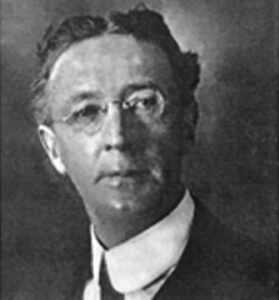Seth Raynor

Seth Jagger Raynor was born in Manorville (Long Island), New York. Raynor was one of the few Architects of his time that did not play or caddy in his youth.
Raynor studied engineering at Princeton University and had his own firm on Long Island. In 1908, at the age of 33, Charles Blair Macdonald hired Raynor to survey his masterpiece, the National Golf Links of America. Macdonald was pleased with his work and asked him to stay on to supervise construction of the course.
Raynor went on to help Macdonald build Piping Rock (1913), Sleep Hollow (1914), and the Greenbrier (1915).
Macdonald, a Scot, was more aristocrat that Golf Course Architect. Macdonald’s friends often asked him to build courses for them. Over time, Macdonald pushed all of these requests to Raynor. With so much work, Seth Raynor left his Engineering firm and became a full-time Golf Course Architect.
There was no record of Seth Raynor ever going to Ireland, Scotland, or Great Britain, to study Golf Architecture in earnest. Everything Raynor learned about Golf and Golf Architecture came from Macdonald. Charles Blair believed that there were 24-27 great holes in the world. The concept of template holes came from this belief, which he passed onto Seth Raynor.
Raynor and Macdonald continued to work together on several famous and important designs, including the Lido Golf Club, which at the time was the most expensive golf course ever built. Seth Raynor went on to build over 65 solo designs, many of which are still in the top 100 today.
Playing a Seth Raynor design for the first time can be jarring. Raynor moved more dirt and sand than any of his contemporaries. His greens were big, bold, and many had severe edges, flanked by flat-bottom bunkers that could be between 10-25 feet below the green surface. Adding to the disorientation when playing approach shots was Raynor’s tendency to build greens which hovered over his fairways, therefore creating doubt in the player’s mind about the exact place to land ones shot as many of these approaches were semi-blind. The final puzzle piece to figure out for the player was wind; which on many of his knoll-style greens can leave shots 15-20 yards short or long of their intended target, depending on the day.
Raynor favored mega-wide fairways with micro-lies abound. Attacking pin positions required a mixture of aerial and run-ups shots, with false fronts and edges that can only be mastered with repeated play. Being in the middle of a Seth Raynor designed fairway is often, not the preferred line.
At Yale, in 1923, Raynor met his protege, Charles Banks, a teacher by trade (with no golf experience), who would go on to create many great designs on his own and subsequently finish at least 10 of Raynor’s projects upon his death.
Seth Raynor was at his peak, having just routed Cypress Point, and finished work at Fishers Island, Lookout Mountain, Yeamans Hall, and Camargo, when he passed away at the age of 51, in West Palm Beach, Florida.
Crown Club Golf Society noted clubs:
Yeamans Hall
Charleston
Lookout
Fishers
Mountain Lake
Watnetonomy
